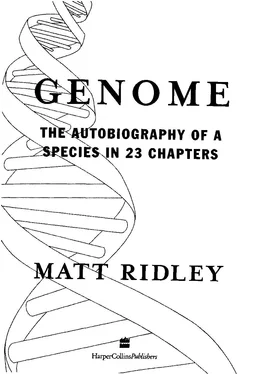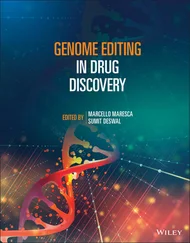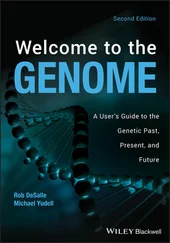Genome - Matt Ridley
Здесь есть возможность читать онлайн «Genome - Matt Ridley» — ознакомительный отрывок электронной книги совершенно бесплатно, а после прочтения отрывка купить полную версию. В некоторых случаях можно слушать аудио, скачать через торрент в формате fb2 и присутствует краткое содержание. Жанр: Старинная литература, на английском языке. Описание произведения, (предисловие) а так же отзывы посетителей доступны на портале библиотеки ЛибКат.
- Название:Matt Ridley
- Автор:
- Жанр:
- Год:неизвестен
- ISBN:нет данных
- Рейтинг книги:5 / 5. Голосов: 1
-
Избранное:Добавить в избранное
- Отзывы:
-
Ваша оценка:
- 100
- 1
- 2
- 3
- 4
- 5
Matt Ridley: краткое содержание, описание и аннотация
Предлагаем к чтению аннотацию, описание, краткое содержание или предисловие (зависит от того, что написал сам автор книги «Matt Ridley»). Если вы не нашли необходимую информацию о книге — напишите в комментариях, мы постараемся отыскать её.
Matt Ridley — читать онлайн ознакомительный отрывок
Ниже представлен текст книги, разбитый по страницам. Система сохранения места последней прочитанной страницы, позволяет с удобством читать онлайн бесплатно книгу «Matt Ridley», без необходимости каждый раз заново искать на чём Вы остановились. Поставьте закладку, и сможете в любой момент перейти на страницу, на которой закончили чтение.
Интервал:
Закладка:
Another famous example of animal learning in an equally simple creature is the case of the sea slug. A more contemptibly basic animal is hard to imagine. It is slothful, small, simple and silent. It has a minute brain and it lives its life of eating and sex with an enviable lack of neurosis. It cannot migrate, communicate, fly or think. It just exists. Compared with, say, a cuckoo or even a bumble bee, its life is a cinch. If the idea that simple animals use instincts and complicated ones learn is right, then the sea slug has no need of learning.
Yet learn it can. If a jet of water is blown upon its gill, it withdraws the gill. But if the jet of water is repeatedly blown on the gill, the M E M O R Y 2 2 3
withdrawal gradually ceases. The sea slug stops responding to what it now recognises as a false alarm. It 'habituates'. This is hardly learning the differential calculus, but it is learning all the same.
Conversely, if given an electric shock once, before water is blown on the gill, the sea slug learns to withdraw its gill even further than usual - a phenomenon called sensitisation. It can also be 'classically conditioned', like Pavlov's famous dogs, to withdraw its gill when it receives only a very gentle puff of water if that gentle puff is paired with an electric shock: thereafter, the gentle puff alone, normally insufficient to make the sea slug withdraw its gill, results in a rapid gill withdrawal. Sea slugs, in other words, are capable of the same kinds of learning as dogs or people: habituation, sensitisation and associative learning. Yet they do not even use their brains. These reflexes and the learning that modifies them occur in the abdominal ganglion, a small nervous substation in the belly of the slimy creature.
The man behind these experiments, Eric Kandel, had a motive other than bothering slugs. He wanted to understand the basic mechanism by which learning occurred. What is learning? What changes occur to nerve cells when the brain (or the abdominal ganglion) acquires a new habit or a change in its behaviour? The central nervous system consists of lots of nerve cells, down each of which electrical signals travel; and synapses, which are junctions between nerve cells. When an electrical nerve signal reaches a synapse, it must transfer to a chemical signal, like a train passenger catching a ferry across a sea channel, before resuming its electrical journey. Kandel's attention quickly focused on these synapses between neurons. Learning seems to be a change in their properties.
Thus when a sea slug habituates to a false alarm, the synapse between the receiving, sensory neuron and the neuron that moves the gill is somehow weakened. Conversely, when the sea slug is sensitised to the stimulus, the synapse is strengthened. Gradually and ingeniously, Kandel and his colleagues homed in on a particular molecule in the sea-slug brain which lay at the heart of this weakening or strengthen-ing of the synapses. The molecule is called cyclic A M P .
Kandel and his colleagues discovered a cascade of chemical 2 2 4 G E N O M E
changes all centred around cyclic A M P . Ignoring their names, imagine a string of chemicals called A, B, C and so on: A makes B,
Which activates C,
Which opens a channel called D,
Thus allowing more of E into the cell,
Which prolongs the release of F,
Which is the neurotransmitter that ferries the signal across the synapse to the next neuron.
Now it so happens that C also activates a protein called C R E B
by changing its form. Animals that lack this activated form of C R E B
can still learn things, but cannot remember them for more than an hour or so. This is because C R E B , once activated, starts switching on genes and thus altering the very shape and function of the synapse. The genes thus alerted are called CRE genes, which stands for cyclic-AMP response elements. If I go into more detail I will drive you back to the nearest thriller, but bear with me, it is about to get simpler again.2
So simple, in fact, that it is time to meet dunce. Dunce is a mutant fruit fly incapable of learning that a certain smell is always followed by an electric shock. Discovered in the 1970s, it was the first of a string of 'learning mutants' to be discovered by giving irradiated flies simple tasks to learn and breeding from those that could not manage the tasks. Other mutants called cabbage, amnesiac, rutabaga, radish and turnip soon followed. (Once again, fruit-fly geneticists are allowed much more liberty with gene names than their human-genetics colleagues.) In all, seventeen learning mutations have now been found in flies. Alerted by the feats of Kandel's sea slugs, Tim Tully of Cold Spring Harbor Laboratory set out to find out exactly what was wrong with these mutant flies. To Tully's and Kandel's delight, the genes that were 'broken' in these mutants were all involved in making or responding to cyclic A M P . 3
Tully then reasoned that if he could knock out the flies' ability M E M O R Y 2 2 5
to learn, he could alter or enhance it as well. By removing the gene for the C R E B protein, he created a fly that could learn, but not remember that it had learnt - the lesson soon faded from its memory.
And he soon developed a strain of fly that learnt so fast that it got the message after a single lesson whereas other flies needed ten lessons to learn to fear a smell that was reliably followed by an electric shock. Tully described these flies as having photographic memories; far from being clever, they over-generalised horribly, like a person who reads too much into the fact that the sun was shining when he had a bicycle accident and refuses thereafter to bicycle on sunny days. (Great human mnemonists, such as the famous Russian Sherashevsky, experience exactly this problem. They cram their heads with so much trivia that they cannot see the wood for the trees. Intelligence requires a judicious mixture of remembering and forgetting. I am often struck by the fact that I easily 'remember' -
i.e., recognise — that I have read a particular piece of text before, or heard a particular radio programme, yet I could not have recited either: the memory is somehow hidden from my consciousness.
Presumably, it is not so hidden in mnemonists' minds.)4
Tully believes that C R E B lies at the heart of learning and memory mechanisms, a sort of master gene that switches on other genes. So the quest to understand learning becomes a genetic quest after all.
Far from escaping from the tyranny of genes by discovering how to learn instead of behave instinctively, we have merely found that the surest way to understand learning is to understand the genes and their products that enable learning to occur.
By now, it will come as no surprise to learn that C R E B is not confined to flies and slugs. Virtually the same gene is present in mice, as well, and mutant mice have already been created by knocking out the mouse CREB gene. As predicted they are incapable of simple learning tasks, such as remembering where the hidden under-water platform lies in a swimming bath (this is standard torture in mouse learning experiments) or remembering which foods were safe to eat. Mice can be made temporarily amnesiac by injecting the
'antisense', or opposite, of the CREB gene into their brains - this 2 2 6 G E N O M E
silences the gene for a while. Likewise, they are super-learners if their CREB gene is especially active.5
And from mice to men is but an evolutionary hair's breadth. We human beings have CREB genes, too. The human CREB gene itself is on chromosome 2, but its crucial ally, which helps CREB
to do its job, called CREBBP, is right here on chromosome 16.
Together with another learning' gene called alpha-integrin, also on chromosome 16, it provides me with a (somewhat weak) excuse for a chapter on learning.
Читать дальшеИнтервал:
Закладка:
Похожие книги на «Matt Ridley»
Представляем Вашему вниманию похожие книги на «Matt Ridley» списком для выбора. Мы отобрали схожую по названию и смыслу литературу в надежде предоставить читателям больше вариантов отыскать новые, интересные, ещё непрочитанные произведения.
Обсуждение, отзывы о книге «Matt Ridley» и просто собственные мнения читателей. Оставьте ваши комментарии, напишите, что Вы думаете о произведении, его смысле или главных героях. Укажите что конкретно понравилось, а что нет, и почему Вы так считаете.












